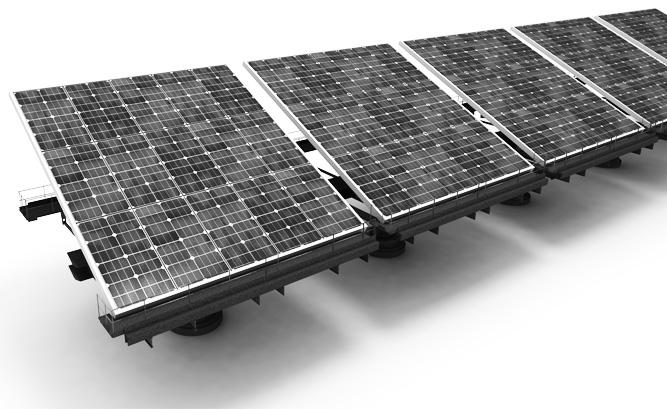
5 minute read
Green
from Oct. 18, 2012
Sun rises over the West
The Obama administration announced plans to move forward with using public lands for solar projects in six Western states, including Nevada, Arizona, Colorado, California, New Mexico and Utah.
Advertisement
The project is the result of the Solar Energy Development Programmatic Environmental Impact Statement (also referred to as just PEIS), a collaborative study conducted by the U.S. Department of Energy, Office of Energy Efficiency and Renewable Energy, Bureau of Land Management, and U.S. Department of Interior.
The report was compiled “in order to assess environmental impacts associated with the development and implementation of agency-specific programs that would facilitate environmentally responsible utility-scale solar energy development,” according to the PEIS website, and it also highlights the zones in which solar energy will be developed.
Nevada’s zones are Amargosa Valley, Dry Lake, Dry Lake Valley North, Gold Point and Millers. The PEIS website also provides information about “public involvement,” such as “protests to land use plan amendments,” for which members of the public can file formal protests against proposed solar development. To read more from the PEIS, including the full downloadable document of the report, visit http://solareis.anl.gov/index.cfm.
Generating energy
Last week, the Desert Research Institute hosted the Energy, Nevada and Economic Development Forum, organized by the Nevada Institute for Renewable Energy Commercialization. The forum brought in more than 70 energy experts throughout the state, who discussed the need to support Nevada’s renewable energy business and education opportunities, emphasizing collaboration between agencies and projects.
Panel discussions were led by members of organizations such as city of Reno Environmental Services, Ormat Technologies, Inc., BrightSource Energy and Southwest Gas, among others. The forum is held annually at DRI.
—Ashley Hennefer
ashleyh@newsreview.com
ECO-EVENT

October is “No GMO” month, and the Great Basin Community Food Co-op will host a screening of documentary Genetic Roulette on Oct. 24. According to the film’s website, it “provides compelling evidence to help explain the deteriorating health of Americans, especially among children, and offers a recipe for protecting ourselves and our future.” Organic, non-GMO popcorn will be served for free, and a panel discussion will be held after the film. People of all ages are invited to attend. Free. For more information, contact Elias Dechent at elias@greatbasinfood.coop.
Got an eco-event? Contact ashleyh@newsreview.com. Visit www.facebook.com/RNRGreen for more.

PHO TO/A SHLEY HENNEFER
Tom Donovan of RT Donovan shows off his composting operation.
Full stream ahead
Keep Truckee Meadows Beautiful’s Waste Stream Tour
After a night of rain, the smell of wet cardboard, trash and compost was prevalent during this year’s Waste Stream Tour, organized by Keep Truckee by Meadows Beautiful. The annual tour takes local green leaders to loca-
Ashley Hennefer tions throughout the region to demonstrate different ways waste is handled—in some cases, handled poorly. ashley@ Eight people participated in the tour, some from local businesses, nonprofnewsreview.com its or state agencies. Christi Cakiroglu, executive director of KTMB, said she invited the candidates running for Reno City Council, who were unable to make the tour because of a senior citizen’s forum held during the same time. She also said that she has yet to get a Reno City Council member to attend. The first stop on the tour was the Waste Management’s Recycle America Facility in Sparks, open since 1991. Here, newspapers, magazines, glass and aluminum are sorted. The newspapers and magazines are sent to China, where it is used to make new newsprint or cardboard. The glass is sent to a benefactor in Sacramento, and aluminum cans are sent to Kentucky, where “within six weeks they end up back on the shelf,” said John Langelle of WM. Participants then stopped by the Lockwood landfill, about 20 minutes outside of Sparks. The landfill generates power by producing methane through its
For a video of this landfill-to-gas system—enough to power more than 1,800 houses—and the year’s tour, visit the electricity is put back into the grid. The landfill has 23 more years before it RN&RGreen reaches its capacity, and is one of the biggest in the country.
Facebook page at Because of this, other companies are trying to pick up the slack by provid-www.newsreview.com /RNRGreen. ing alternative options for waste use. RT Donovan is one of few local places that accepts green waste, and also produces compost. Owner Tom Donovan discussed the uses of green waste, such as using compost for erosion control. “There is no legislative mandate to keep green waste out of a landfill,” he said. Donovan noted some of the challenges that come with composting, including small items that most people don’t think about, like the stickers that come on produce. “You’d think those stickers would just be paper with adhesive, but they are actually made out of plastic,” he said. “They’ve made this thing so they essentially never break down.” But a drive out to illegal dump sites in Golden Valley showed that despite the available resources, some members of the public choose to bypass legal disposal all together. The bumpy dirt road into the hills revealed many areas of litter, including several acres of broken glass, as well as piles of old tires, mattresses and televisions riddled with holes from bullets from hobby shooters. “People don’t realize the extent illegal dumping occurs to our community,” said Cakiroglu. The final stop on the tour was at Waste Management’s transfer station. Representatives of WM also demonstrated how medical and biohazard waste are safely handled through a compacting and heating process. Cakiroglu hopes that projects like the tour will show the community what’s working well and what needs to be improved. “It’s an exciting time for trash because there are a lot of changes happening,” she said. KTMB is creating a video version of the tour for those who can’t attend in person, and Cakiroglu hopes the video will be shown in local schools. Ω










